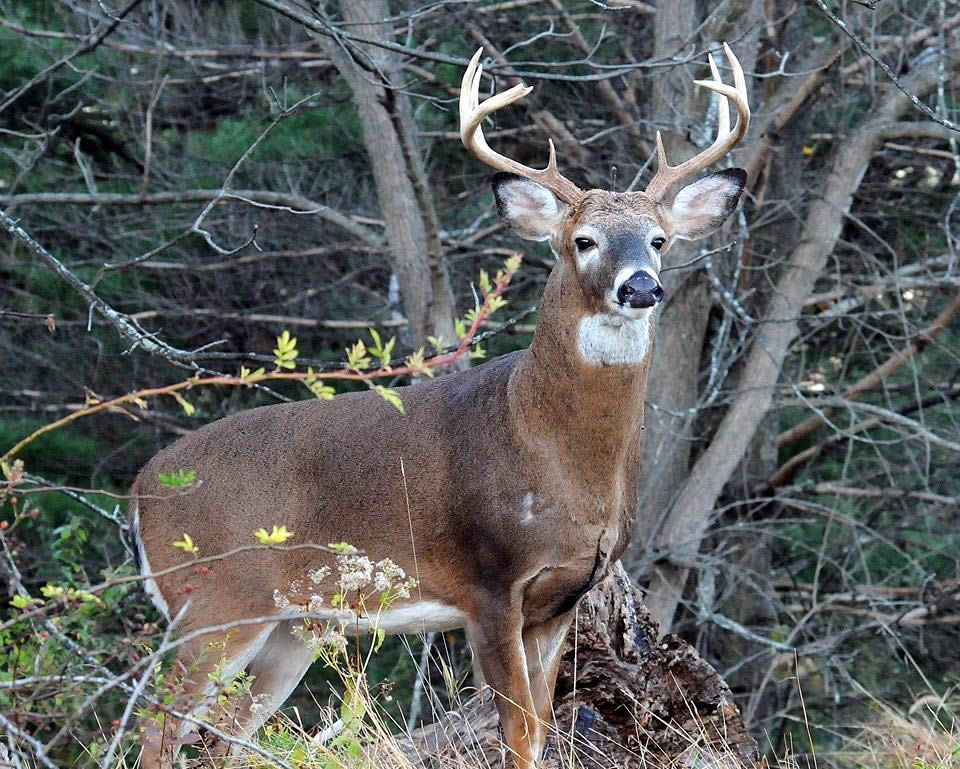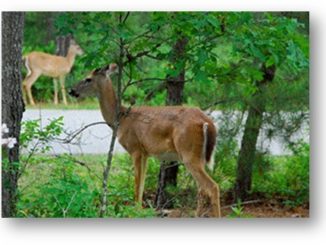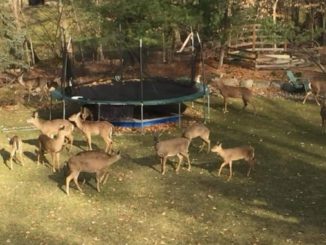
BY MICHAEL OLOHAN
OF PASCACK PRESS
RIVER VALE, N.J.—After presenting—and discounting—every non-lethal option to reduce deer population, representatives from a state fish and wildlife agency told River Vale’s Township Council Dec. 10 that only a regulated deer hunt will be effective to control deer population increases.
Although state wildlife officials presented their deer management options first, Township Council members will hear more about non-lethal options from the Animal Protection League of New Jersey on Jan. 28, and may make a decision soon after to reduce local deer population.
In early October, River Vale Mayor Glen Jasionowski told area mayors at a Greater Pascack Valley Chamber of Commerce event that although he had always opposed hunting, he had concluded that River Vale needed a hunt to control increasing deer population.
Following public pushback, Jasionowski and council members offered to hear both sides of the deer management issue, inviting advocates of lethal and non-lethal alternatives to address the council.
Jasionowski noted an increase in deer-auto incidents from an average two to four yearly incidents eight years ago to more than 50 such auto incidents in 2018.
He also cited concerns about Lyme disease and worse-case, someone being seriously hurt or killed in a deer-related accident before the township acts to reduce deer population.
Non-lethal not effective
Mostly, the state wildlife officials said non-lethal approaches were proven ineffective, and detailed why each alternative was not workable. They said approaches that do not reduce deer population included sterilization, contraceptives, and roadside signage and mirrors.
“Regulated hunting is the last and most effective way to manage deer. It’s a proven effective deer management tool for years, hundreds of years. It’s least expensive for municipalities and practical and flexible to meet biological and social needs. It can be fit to whatever you guys needs and feel comfortable with,” said Jodi Powers, Division of Fish and WIldlife senior wildlife biologist.
Powers said the state is trying to decrease deer population in across 75 percent of New Jersey and highlighted a state map indicating extended deer hunting seasons, which include developing areas with increased amounts of deer habitat, such as River Vale.
“After today’s presentation it will take a lot to convince me that something other than a hunt is the way to go.”
—River Vale Mayor Glen Jasionowski
‘Regulated hunt’ effective
Powers said “regulated hunting” during the state’s normal deer hunting season would be an effective approach in River Vale, which would be “a controlled managed hunt during the regular season.”
She said Saddle River was currently “doing regulated hunting with a select group of [bow] hunters.”
Initially, Saddle River applied for approval of a non-lethal method—surgical sterilization of does—but their proposal was rejected by the state Fish and Game Council, Powers said.
She said most non-lethal methods, including male vasectomies, female ovariectomies, and contraceptive controls, “are not effective in free-range populations” and generally not approved by Fish and Wildlife Council.
The NJDEP’s Division of Fish and Wildlife acts as an intermediary between municipalities and the state council for developing hunting and non-lethal options.
‘Creatures of habit’
Powers was asked whether hunting or culling led to increased deer reproduction rates. She said that was “a myth” and that, because the area was not at its biological carrying capacity, residents would not see an increase in deer following a controlled local hunt.
She said deer were “creatures of habit” and would take awhile to repopulate an area where population had been reduced.
Councilman Ari Ben-Yishay pressed Powers about whether a non-lethal plan would be approved by the Fish & Game Council.
She said although the state Council has not yet approved a non-lethal plan, “if it was structured in a thorough complete way” the Fish and Game Council may approve a such a plan.
Ben-Yishay said “We are very limited in what type of deer control we can institute just based on the mechanism of how this works.”
Powers said the Division of Fish and Wildlife could assist River Vale in developing a controlled hunting plan for evaluation and approval of state Fish and Game Council.
“There’s been tons and tons of research on non-lethal methods and none of them are effective,” said Powers, noting any non-lethal plan proposed would be considered an experiment.
Another state wildlife biologist, Cindy Kuenstner, said several local ordinances would need to be revised before a regulated, controlled hunt could take place on municipal properties.
Kuenstner listed all requirements and safety precautions taken for a regulated hunt to reduce deer population.
She said about 74 percent of state residents polled supported regulated hunting. She called it “the only effective, efficient, legal, approved way to reduce [deer] population.”
Bromberg wondered if the state knew how many deer populate River Vale, but Powers said no current estimates exist though local deer-per-mile statistics can be estimated based on surveys state officials can assist with.
‘Not one and done’
“The [deer] problem started to inch up and then it just shot up,” said Jasionowski, commenting on how quickly the deer population increased.
Powers said a controlled hunt “is not a one and done… It’s going to be a yearly maintenance thing,” should the council decide to go with a controlled hunting program.
Powers claimed annual hunting reduces deer population by about 50,000 deer, but she noted under “optimal conditions” deer populations could double yearly, making deer population control important.
Powers said it “would be very difficult” to determine when an area such as RIver Vale could reach its “biological carrying capacity,” or an area’s ability to support a certain population of deer.
She said now the state manages deer based on “cultural carrying capacity” or the number of deer that residents in a specific area can tolerate. She said protecting forest health is also another important goal for deer management.
Powers said deer play an important part in an ecosystem and the state’s approach is “to bring it back into balance.” A deer’s home range spans about a mile, though bucks often travel further in search of female deer, she said. An average doe breeds at a year old, and may give birth to one or two—sometimes three—fawns per year with most does
living approximately four years, Power said.
Deer are “an edge species” and prefer to live where a forested area meets fields or open space, said Powers, adding that developments or subdivisions “create a habitat that they prefer.”
Powers said the “majority of New Jersey is in private land ownership” and that prevents hunting to manage deer populations.
Powers noted that more food to eat, including ornamental plants and human feeding of deer, help deer to reproduce.
River Vale recently passed an ordinance to prohibit deer feeding by homeowners.
Other issues underlying increased deer numbers include elimination of predators, such as wolves and mountain lions, an increase in parks and open space where deer congregate, and laws banning local hunting.
‘27,000 deer-auto accidents’
Powers noted deer–vehicle accidents are indicators of an “overpopulation of deer” and noted last year State Farm Auto Insurance Company reported 27,000 vehicle-deer accidents per year. Powers said it’s likely that closer to 40,000 deer–vehicle collisions occur yearly as many such accidents go unreported.
Kuenstner said it “would be reasonable to start now,” to implement a local hunting program by next September’s deer season.
After the meeting Jasionowski and Bromberg said they looked forward to hearing more on non-lethal deer reduction methods. Bromberg said no one wants a local resident to suffer harm from a deer–vehicle collision. Jasionowski said he’s hearing complaints about deer “every day.”
“I haven’t made my mind up yet…I believe we have to cull the herd,” added Jasionowski. “After today’s presentation it will take a lot to convince me that something other than a hunt is the way to go.”



